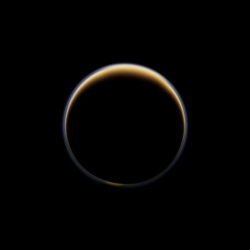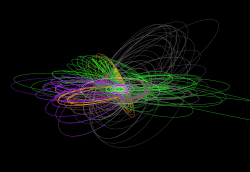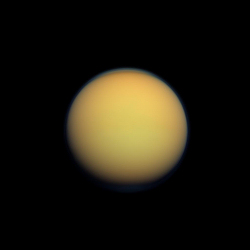The active Sun boosts Titan's outer atmosphere
15 October 2013
The NASA-ESA-ASI Cassini spacecraft has been observing the Saturn system, including the giant satellite Titan, for more than 9 years. A detailed analysis of Cassini data has now confirmed predictions that the density of Titan's ionosphere is directly linked to the 11 year cycle of solar activity.
 |
| Sunlight scattering through the periphery of Titan's atmosphere forms a ring of colour. Credit: NASA/JPL-Caltech/Space Science Institute |
All planets and satellites with atmospheres possess an ionosphere, a region in the upper atmosphere which is dominated by ionised (electrically charged) particles – electrons and ions. These ionospheres are formed mainly from the photoionisation of the atmosphere, which occurs when solar X-rays and extreme ultraviolet (EUV) radiation split atmospheric molecules into ions and electrons. As a result, the density of the ionosphere peaks above the planet's day hemisphere and is much lower above the night side.
The existence of an ionosphere high above the surface of planet-sized Titan has been known since it was first observed by radio occultation measurements from the Voyager 1 spacecraft in November 1980. However, most of our knowledge about the moon's ionosphere has been established following the entry of the Cassini spacecraft into orbit around Saturn in July 2004.
Larger than Mercury, Titan is blanketed with a dense, orange haze of organic molecules which hides the satellite's icy surface. As on Earth, the most abundant gas in the atmosphere is nitrogen. However, unlike our world, Titan's ionosphere is dominated by quite complex organic compounds, such as HCNH+ (protonated hydrogen cyanide) and C2H5+ (an ethyl group). There is also a wealth of other minor species present, formed through the chemistry in the moon's upper atmosphere.
The primary ionisation source for Titan's atmosphere is the solar EUV flux. Impacting particles trapped in Saturn's magnetosphere play a minor role in establishing the dayside ionosphere, but have a larger effect on the night side.
The structure of the ionosphere has been studied extensively during the Cassini mission. The peak density is located 1000 – 1300 km above the surface, with a decrease in altitude where the Sun is higher above the horizon. The maximum electron density is typically about 3000 particles per cubic cm on the dayside, compared with about 1000 particles per cubic cm on the night side.
The variability of Titan's ionospheric structure has also been studied since the arrival of Cassini. Remote measurements by radio occultation, as well as measurements by instruments on board Cassini, have revealed that the structure and density can vary significantly with time.
 |
| This picture traces different phases of Cassini's tour of the Saturnian system. Credit: NASA/JPL-Caltech |
One of the advantages of inserting a multi-instrumented spacecraft, such as Cassini, into orbit around a planet is the long-term continuity of scientific data, enabling changes over time to be monitored and analysed.
An international team of scientists has now taken advantage of this longevity to compare the amount of ionisation at Titan during different stages of the 11 year solar cycle. The data they used were obtained by the Langmuir probe instrument, part of the radio and plasma wave science instrument on board Cassini. The Langmuir probe is used to monitor the density, temperature and bulk speed of plasma (electrons and ions) as the spacecraft orbits Saturn.
Writing in the Journal of Geophysical Research: Space Physics, the authors compare measurements obtained at the beginning of the mission, when the solar activity was at a moderate-to-low level of activity, with data from recent flybys completed at a time of fairly high solar activity.
When the measurements are corrected for the different flyby geometry and position of the overhead Sun, their analysis shows a definite correlation between the amount of ionisation in Titan's ionosphere and level of solar activity.
"We found that the varying EUV flux during the solar cycle strongly influenced the peak electron density of Titan's ionosphere," said Niklas Edberg, a post-doctoral researcher at the Swedish Institute of Space Physics in Uppsala, Sweden, and lead author of the paper.
 |
| A natural colour view of Saturn's moon Titan. Credit: NASA/JPL-Caltech/Space Science Institute |
"From the first Titan flyby of the Cassini mission on 26 October 2004 until T71 (the 72nd close pass of Titan) on 7 July 2010, it was not possible to identify any large changes in the structure of the ionosphere in response to either solar cycle changes or seasonal changes in Titan's atmosphere," said Edberg.
"However, after 2010, solar activity picked up rapidly and our analysis showed that, during six Titan flybys between May 2012 and November 2012, the electron density in the ionospheric peak region, as measured by the Langmuir probe on Cassini, increased by 15-30%, compared to the previous average."
This marked increase in the density of the ionosphere coincided with increasing solar activity, even though Titan received a smaller percentage of incoming solar radiation due to Saturn's elliptical orbit and increasing distance from the Sun. During 2004 - 2012, Saturn moved outward from the Sun by more than 100 million km.
"The ionospheric peak electron densities during the more recent Titan flybys are significantly increased compared to measurements from previous flybys, and the peaks are generally also found at lower altitudes in the ionosphere than previous average values," said Edberg.
The teams' results are in very good agreement with existing theory, which predicts that the production rate of ions and electrons should be proportional to the square root of the ionising flux increase.
It is interesting to note that most of the Cassini measurements of Titan's ionosphere have occurred during a very special era - the deepest solar minimum since the seventeenth century. As a result, the peak densities measured as the current solar cycle heads towards maximum have been lower than in previous cycles.
Theoretical calculations show that ionospheric peak electron density during periods of higher solar activity should exceed 6500 particles per cubic cm at the subsolar point. This is 85 - 160% more than what has been observed by Cassini as that latest solar cycle reaches its peak.
"Nearly the same mechanisms exist at Earth, where the possible long-term effects of solar cycles on Earth's climate evolution are debated," said Nicolas Altobelli, ESA's Cassini project scientist.
"Titan is often referred to as a primitive Earth in deep freeze, so it is fascinating to compare the physical processes taking place in the upper atmospheres of these two worlds."
Background information
The results described in this article are reported in "Solar cycle modulation of Titan's ionosphere", by N. J. T. Edberg et al , published in the Journal of Geophysical Research: Space Physics, Volume 118, Issue 8, pages 5255-5264, August 2013; doi:10.1002/jgra.50463
The Cassini–Huygens mission is a cooperative project of NASA, ESA and the Italian Space Agency (ASI). Launched in 1997, Cassini arrived in the Saturn system in 2004 and is studying the ringed planet and its moons. The Huygens probe was released from the main spacecraft and, in 2005, parachuted through the atmosphere to the surface of Saturn's largest moon, Titan.
NASA's Jet Propulsion Laboratory, a division of the California Institute of Technology in Pasadena, manages the mission for NASA's Science Mission Directorate, Washington, D.C.
Contacts
N. J. T. Edberg
Swedish Institute of Space Physics
Uppsala, Sweden
Email: ne![]() irfu.se
irfu.se
Phone: +46-18-4715904
Nicolas Altobelli
ESA Cassini-Huygens Project Scientist
Directorate of Science and Robotic Exploration
European Space Agency
Email: nicolas.altobelli![]() sciops.esa.int
sciops.esa.int
Phone: +34-918131201



